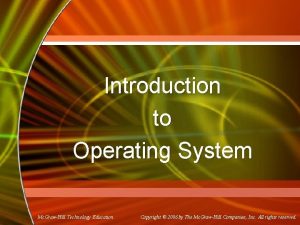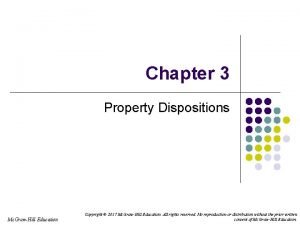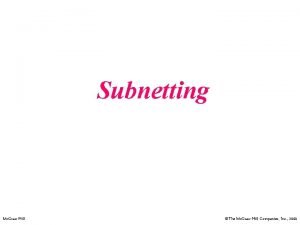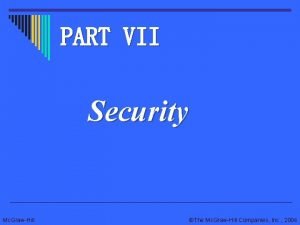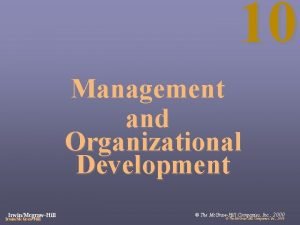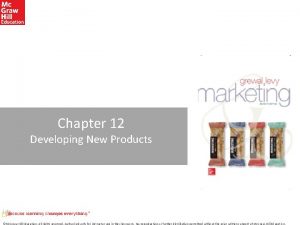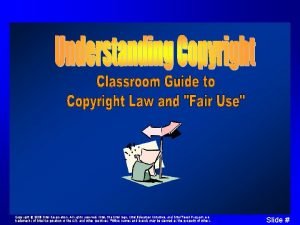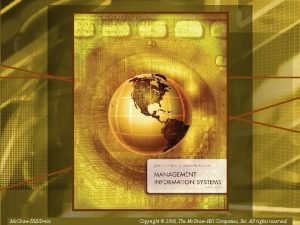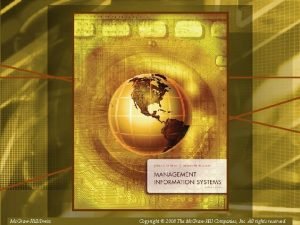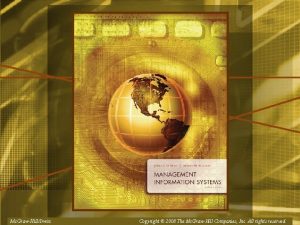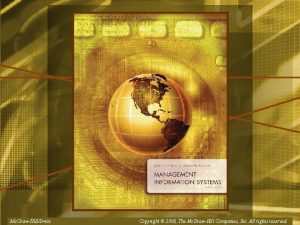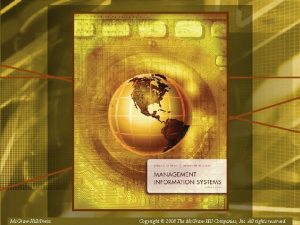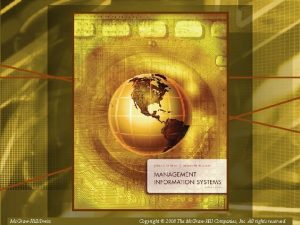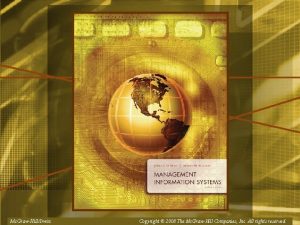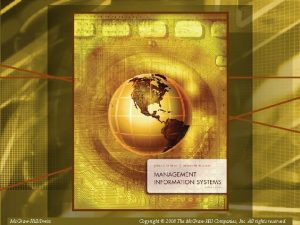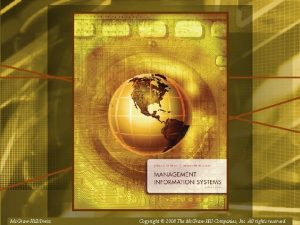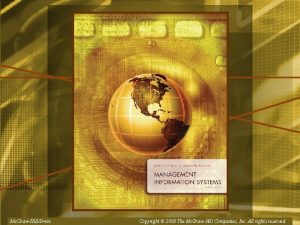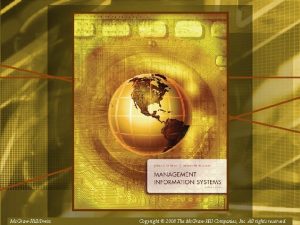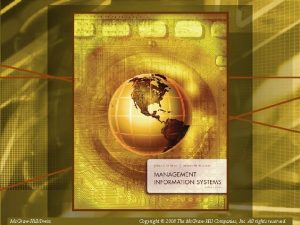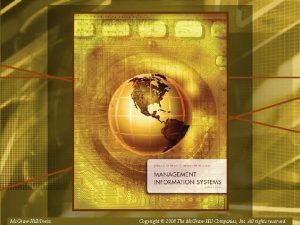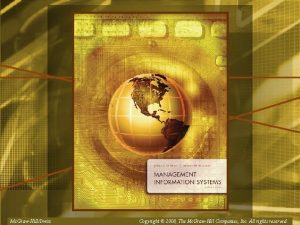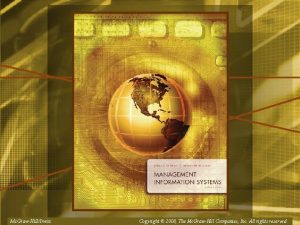Mc GrawHillIrwin Copyright 2008 The Mc GrawHill Companies






























- Slides: 30

Mc. Graw-Hill/Irwin Copyright © 2008, The. Mc. Graw-Hill. Companies, Inc. Allrightsreserved.

Chapter 5 Data Resource Management Mc. Graw-Hill/Irwin Copyright © 2008, The. Mc. Graw-Hill. Companies, Inc. Allrightsreserved.

Logical Data Elements 3

Logical Data Elements • Character • A single alphabetic, numeric, or other symbol • Field or data item • Represents an attribute (characteristic or quality) of some entity (object, person, place, event) • Examples: salary, job title • Record • Grouping of all the fields used to describe the attributes of an entity • Example: payroll record with name, SSN, pay rate 4

Logical Data Elements • File or table • A group of related records • Database • An integrated collection of logically related data elements 5

Database Structures • Common database structures… • • • Hierarchical Network Relational Object-oriented Multi-dimensional 6

Relational Structure • Most widely used structure • Data elements are stored in tables • Row represents a record; column is a field • Can relate data in one file with data in another, if both files share a common data element 7

Relational Operations • Select • Create a subset of records that meet a stated criterion • Example: employees earning more than $30, 000 • Join • Combine two or more tables temporarily • Looks like one big table • Project • Create a subset of columns in a table 8

Multidimensional Model 9

Object-Oriented Structure • An object consists of • Data values describing the attributes of an entity • Operations that can be performed on the data • Encapsulation • Combine data and operations • Inheritance • New objects can be created by replicating some or all of the characteristics of parent objects 10

Object-Oriented Structure Source: Adapted from Ivar Jacobsen, Maria Ericsson, and Ageneta Jacobsen, The Object Advantage: Business Process Reengineering with Object Technology (New York: ACM Press, 1995), p. 65. Copyright @ 1995, Association for Computing Machinery. By permission. 11

Data Dictionary • A data dictionary • Contains data about data (metadata) • Relies on specialized software component to manage a database of data definitions • It contains information on. . • The names and descriptions of all types of data records and their interrelationships • Requirements for end users’ access and use of application programs • Database maintenance • Security 12

Data Planning Process • Database development is a top-down process • Develop an enterprise model that defines the basic business process of the enterprise • Define the information needs of end users in a business process • Identify the key data elements that are needed to perform specific business activities (entity relationship diagrams) 13

Entity Relationship Diagram 14

Data Resource Management • Data resource management is a managerial activity • Uses data management, data warehousing, and other IS technologies • Manages data resources to meet the information needs of business stakeholders 15

Distributed Databases • Distributed databases are copies or parts of databases stored on servers at multiple locations • Improves database performance at worksites • Advantages • • Protection of valuable data Data can be distributed into smaller databases Each location has control of its local data All locations can access any data, any where • Disadvantages • Maintaining data accuracy 16

Distributed Databases • Replication • Look at each distributed database and find changes • Apply changes to each distributed database • Very complex • Duplication • One database is master • Duplicate the master after hours, in all locations • Easier to accomplish 17

External Databases • Databases available for a fee from commercial online services, or free from the Web • Examples: hypermedia databases, statistical databases, bibliographic and full text databases • Search engines like Google or Yahoo are external databases 18

Hypermedia Databases • A hypermedia database contains • Hyperlinked pages of multimedia • Interrelated hypermedia page elements, rather than interrelated data records 19

Data Warehouses • Stores static data that has been extracted from other databases in an organization • Central source of data that has been cleaned, transformed, and cataloged • Data is used for data mining, analytical processing, analysis, research, decision support • Data warehouses may be divided into data marts • Subsets of data that focus on specific aspects of a company (department or business process) 20

Data Warehouse Components 21

Applications and Data Marts 22

Data Mining • Data in data warehouses are analyzed to reveal hidden patterns and trends • Market-basket analysis to identify new product bundles • Find root cause of qualify or manufacturing problems • Prevent customer attrition • Acquire new customers • Cross-sell to existing customers • Profile customers with more accuracy 23

Traditional File Processing • Data are organized, stored, and processed in independent files • Each business application designed to use specialized data files containing specific types of data records • Problems • • Data redundancy Lack of data integration Data dependence (files, storage devices, software) Lack of data integrity or standardization 24

Database Management Approach • The foundation of modern methods of managing organizational data • Consolidates data records formerly in separate files into databases • Data can be accessed by many different application programs • A database management system (DBMS) is the software interface between users and databases 25

Common DBMS Software Components • Database definition • Language and graphical tools to define entities, relationships, integrity constraints, and authorization rights • Nonprocedural access • Language and graphical tools to access data without complicated coding • Application development • Graphical tools to develop menus, data entry forms, and reports 26

Database Interrogation • End users use a DBMS query feature or report generator • Response is video display or printed report • No programming is required • Query language • Immediate response to ad hoc data requests • Report generator • Quickly specify a format for information you want to present as a report 27

Database Interrogation • SQL Queries • Structured, international standard query language found in many DBMS packages • Query form is SELECT…FROM…WHERE… 28

Database Interrogation • Graphical and Natural Queries • It is difficult to correctly phrase SQL and other database language search queries • Most DBMS packages offer easier-to-use, point-and-click methods • Translates queries into SQL commands • Natural language query statements are similar to conversational English 29

Graphical Query Wizard 30
 2008 2008
2008 2008 Mc grawhill
Mc grawhill 作業管理精簡版13版解答
作業管理精簡版13版解答 Grawhill
Grawhill Grawhill
Grawhill Mc grawhill
Mc grawhill Grawhill
Grawhill Mc graw hill
Mc graw hill Grawhill
Grawhill Grawhill
Grawhill Copyright 2008
Copyright 2008 Copyright 2008
Copyright 2008 2008 pearson prentice hall inc
2008 pearson prentice hall inc Copyright 2008
Copyright 2008 Copyright 2008
Copyright 2008 Copyright 2008
Copyright 2008 Redistribution prohibited
Redistribution prohibited Thế nào là hệ số cao nhất
Thế nào là hệ số cao nhất Sơ đồ cơ thể người
Sơ đồ cơ thể người Ng-html
Ng-html Các số nguyên tố là gì
Các số nguyên tố là gì đặc điểm cơ thể của người tối cổ
đặc điểm cơ thể của người tối cổ Cách giải mật thư tọa độ
Cách giải mật thư tọa độ Các châu lục và đại dương trên thế giới
Các châu lục và đại dương trên thế giới Tư thế worm breton là gì
Tư thế worm breton là gì ưu thế lai là gì
ưu thế lai là gì Thẻ vin
Thẻ vin Tư thế ngồi viết
Tư thế ngồi viết Cái miệng bé xinh thế chỉ nói điều hay thôi
Cái miệng bé xinh thế chỉ nói điều hay thôi Các châu lục và đại dương trên thế giới
Các châu lục và đại dương trên thế giới Từ ngữ thể hiện lòng nhân hậu
Từ ngữ thể hiện lòng nhân hậu

